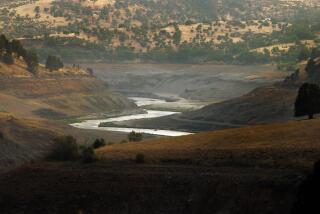Dwindling Ethnic Group Struggles to Keep Ancestral Land in Malaysia
- Share via
KUALA KUBU BARU, Malaysia — Ramsit Anggong places his hand over his heart and swears he and his ancestors have been the guardians of this slip of rain forest along the Selangor River for at least 12,000 years. Generation after generation has passed down its hunting and healing secrets, appeased and protected the river dragons and forest spirits, courted under the same mango trees.
“This is the place where my father and mother fell in love. It is the place where I fell in love,” said Ramsit, the 39-year-old batin, or headman, of Gerachi village.
“If this place is lost--our memories are lost.”
But the Malaysian government, worried by the drought that left 2 million people in the capital on water rationing for several months last year, intends to build a dam that would submerge Ramsit’s village and neighboring Pertak.
Ramsit and the 340 people in both villages are not typical Malaysians who could pack up and put down roots in another riverfront town. They are Orang Asli, or the “original people” of Malaysia whose way of life, little altered for centuries, faces extinction.
“It would be a loss of our connection to the ancestors because their graves are here,” said Mak Minah Anggong, 68, Ramsit’s mother and a popular Orang Asli ceremonial singer. “The land is our only link to our origins. Long before the white man and the Chinese man came, we were here.”
The Temuan, one of 18 Orang Asli ethnic groups on peninsular Malaysia, date back some 15,000 years, said Colin Nicholas, head of the Center for Orang Asli Concerns.
There are only 105,000 Orang Asli remaining. Some blame their dwindling numbers on excessive logging and Malaysia’s push to become a developed nation by 2020. Others point to the government’s assimilation policy to move them out of their villages and integrate them into the Malay community.
Prime Minister Mahathir Mohamad’s Vision 2020 program has brought well-deserved benefits to the majority Malays. But it has devastated the Orang Asli, who, much like American Indians, have been forced off lands they cultivated and cherished for centuries.
The Orang Asli believe their souls are bound by the surrounding mountains. As animists, they feel they are the deans of indigenous plants and sacred shrines.
“Their identity is linked to the land,” said Nicholas. “Every tree has got a name, every place an identification. . . . The legends and history, the more you know about your land, the more you gain respect.”
The government decreed in 1961, however, that although legend and history were fine, the future of the Orang Asli was with the Malays.
“We want them to be fully integrated into the mainstream. We want to see them to be just like any other Malaysian citizen,” said Ahmad Saleh Sarif, director of the government Department of Orang Asli Affairs. “The Orang Asli out there just have to open up and adjust themselves to the so-called global village. If they choose to remain isolated, it will lead them nowhere.”
But nowhere is where many Orang Asli want to be.
The Orang Asli in Pertak and Gerachi villages, about 40 miles north of Kuala Lumpur, the capital, still live in wooden slat houses along the river.
As the children bathe and fish in the Selangor River, the women strip bamboo to sell to joss-stick and candlestick makers. They are happy, and most are healthy.
Ahmad Saleh said the families, who are on state land that does not officially belong to them, will be compensated for making way for the dam. They will get new houses and land for their orchards, he said. Their ancestral graves will be relocated, their children educated.
But similar promises made to other villages have not always been kept, and the government faces a slew of lawsuits by Orang Asli who say they have been cheated.
“And even if they put you in a new house, you’re still a man with a broken heart,” Ramsit said. “Material objects mean nothing to us. Our spiritual connections here are more important. We would be the last generation.”
Ramsit, a father of five who earns about $2,600 a year from his durian fruit harvest, recently began working as a white-water rafting guide in line with the government’s push to promote ecotourism.
But the dam, scheduled for completion in 2004, would flood not only the Orang Asli villages, but also several white-water rafting firms, privately owned fish farms and rubber plantations.
Ramsit was recently interrogated by police because of comments he made in a local newspaper about resorting to poison blowpipes to stop the dam builders. Tough talk, yet he and the other men of the villages concede they’ll likely lose the battle.
The Orang Asli hold little trust for the Malays. Although slavery was banned in 1884, raids by Malays on Orang Asli villages were common into the early 1900s. The men were killed, and the women and children sold into slavery.
“There is a historical basis for the fear and disgust,” said Nicholas. “This is very fresh in Orang Asli minds today.”
Water at the three dams that feed Kuala Lumpur and the surrounding Klang Valley dropped to critical levels last year.
A severe regional drought caused by the El Nin~o weather phenomenon was partly to blame. But government officials admit that mismanagement, wasteful habits by urban dwellers and poor long-term planning were also at fault.
“We know the people of Kuala Lumpur are running out of water,” Ramsit’s mother said. “But why should we become the victims of other people’s waste?”
More to Read
Sign up for Essential California
The most important California stories and recommendations in your inbox every morning.
You may occasionally receive promotional content from the Los Angeles Times.













